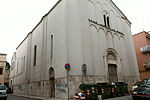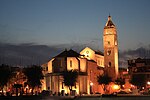Battle of Montemaggiore
1040s in the Byzantine Empire1041 in EuropeBattles involving the Byzantine EmpireBattles involving the Varangian GuardBattles of the Byzantine–Norman wars ... and 3 more
Battles of the Norman conquest of southern ItalyCatepanate of ItalyConflicts in 1041

The Battle of Montemaggiore (or Monte Maggiore) was fought on 4 May 1041, on the river Ofanto near Cannae in Byzantine Italy, between Lombard-Norman rebel forces and the Byzantine Empire. The Norman William Iron Arm led the offence, which was part of a greater revolt, against Michael Dokeianos, the Byzantine Catepan of Italy. Suffering heavy losses in the battle, the Byzantines were eventually defeated, and the remaining forces retreated to Bari. Dokeianos was replaced and transferred to Sicily as a result of the battle. The victory provided the Normans with increasing amounts of resources, as well as a renewed surge of knights joining the rebellion.
Excerpt from the Wikipedia article Battle of Montemaggiore (License: CC BY-SA 3.0, Authors, Images).Battle of Montemaggiore
Contrada Fiumara, Barletta Fiumara
Geographical coordinates (GPS) Address Nearby Places Show on map
Geographical coordinates (GPS)
| Latitude | Longitude |
|---|---|
| N 41.35 ° | E 16.216666944444 ° |
Address
Contrada Fiumara
Contrada Fiumara
Barletta, Fiumara
Apulia, Italy
Open on Google Maps









